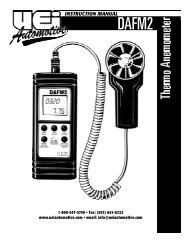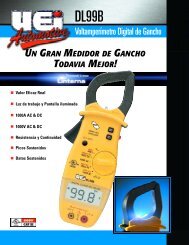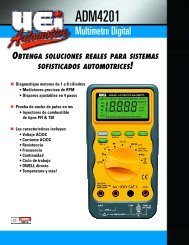Manual - UEi Automotive
Manual - UEi Automotive
Manual - UEi Automotive
Create successful ePaper yourself
Turn your PDF publications into a flip-book with our unique Google optimized e-Paper software.
Ground Test<br />
This function is designed to locate bad grounds, voltage drops,<br />
intermittent connections, or any source of high resistance in automotive<br />
electrical circuits and grounds.<br />
If provides a very efficient check of a vehicle’s electrical system condition.<br />
This test works by measuring the voltage drop across any cable to which<br />
it is connected. The amount of voltage drop is displayed as “9 o o d” ,<br />
“S U S P”, “b A d”, and “O P E n” annunciators in the secondary display.<br />
1. Set rotary selector to “Elec” position.<br />
2. Press the menu key 2 to select “Ground Test” function. “OFL” is<br />
displayed in the primary display and “OPEn” is displayed in the<br />
secondary display.<br />
3. Insert black lead into “COM” terminal and red lead into<br />
“Elec” terminal (Fig 15).<br />
4. Connect the two probes to the cable being tested. A good<br />
connection is indicated by the display of “9ood” in the<br />
secondary display.<br />
5. Apply power to the vehicle. The condition of the cable between<br />
the two probes is indicated by either “9ood”, “SUSP”, or “bAd”<br />
in the secondary display.<br />
Secondary Display<br />
Primary Display<br />
(Amount of Voltage Drop)<br />
9ood<br />
< 0.1999 V<br />
(Good)<br />
SUSP<br />
0.2000 ~ 0.3999 V<br />
(Suspect)<br />
bAd 0.4000 ~ 1.9999<br />
(Bad)<br />
OPEn<br />
> 2.0000 V<br />
(Open)<br />
If either “SUSP” or “bAd” is displayed, check the cable closely for poor<br />
connections between the two test leads. Make certain all connectors are<br />
clean and secure.<br />
NOTE: When checking ground connections, always clean or scrape off<br />
the area of the chassis where the ground lead is being connected. Dirt,<br />
grease, and paint are insulators and will prevent the unit from making<br />
a good connection. If a ground connection is suspect, connect the unit<br />
to the chassis as close as possible. When testing charging or starting<br />
circuits from the battery, always make the first connection to the battery<br />
post, and not the battery connector. Corrosion on the battery post and<br />
connector surfaces can be the source of the problem very frequently.<br />
O2 Sensor<br />
This is a very efficient method to check and simulate O2 Sensors.<br />
This test hooks in parallel with the O2.<br />
Sensor circuit. The primary display will show O2 Sensor voltage, while<br />
the secondary display will show Cross Counts (CC).<br />
Cross Counts are the number of times the reading crosses 0.45 V DC<br />
per second.<br />
Nominal CC is 1 to 3 for a good O2 Sensor.<br />
During this test, the secondary display will indicate Full Lean, Lean,<br />
Rich, and Full Rich respectively, according to the measuring value of the<br />
O2 Sensor output, together with the corresponding Cross Counts (.X).<br />
Chassis<br />
Ground<br />
Primary Display Secondary Displayed < 0.1999<br />
< 0.29999 V FL. X (Full Lean)<br />
0.3000 ~ 0.4499 V FL. X (Lean)<br />
0.4500 ~ 0.5999 V FL. X (Rich)<br />
> 0.6000 V FL. X (Full Rich)<br />
(Fig 15)<br />
Also during this test the menu key 3 (Lean) or menu key 4 (Rich) might<br />
be pressed to send out a rich command or a lean command for 5<br />
seconds, which will make the “Lean” or “Rich” annunciator or menu<br />
screen flash depending upon which was commended. During this time<br />
the primary display will show the signal level that is at the O2 sensor to<br />
see that the condition is being compensated for. The green lead is<br />
required to be connected between the “Signal” terminal and the O2<br />
connector on the ECM side.<br />
NOTE: Signal out and CC may not function properly on some Toyota<br />
O2 Sensors.<br />
ADM5201-MAN P. 9













